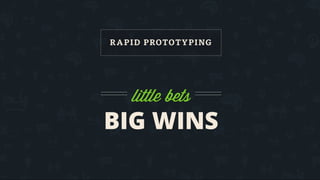Editor's Notes
- #4: Jeff Today weŌĆÖre here to show you how to use prototyping to take little bets, for big wins Part of a bigger discussion that we have with clients. We tried to whittle it down to the most important points and tips. Rapid prototyping - a means to an ends. ItŌĆÖs part of a larger strategy around to promote innovation.
- #5: i think itŌĆÖs important to talk about the problem we trying to solve. so iŌĆÖm going to set that up first.
- #6: LetŌĆÖs talk about a concept we call Idea Mortality Rate. IŌĆÖm skipping ahead a few steps here because iŌĆÖm assuming that I donŌĆÖt need to convince you that firms want to innovate. WhatŌĆÖs stopping firms from innovating isnŌĆÖt generally a shortage if ideas. ItŌĆÖs their IMR.
- #7: One of two things happenŌĆ”
- #8: You end up with an idea blackhole. People donŌĆÖt want to share any ideas or the org wonŌĆÖt approve projects. lotŌĆÖs of things factor into this.
- #9: Dying at the right time. Cull the heard
- #11: Erik Two ways to look at this: There were aspects that were valuableŌĆ”.didnŌĆÖt need to spend millions to get there. Microsoft KIN, Apple Newton both made it to marketŌĆ”.but never should have. Took too long to realize it wasnŌĆÖt a good idea. The learnings carried over Metro-style UI carried over to Windows Phone 8 The ARM processor cam out of it, which was used in future Apple mobile devices including a variation in the iPhone
- #12: Our goal today - help you find Goldilocks (idea factory)
- #14: Little Bets book by Peter Sims Ideas are similar, but different three places we see projects miss when it comes to innovating
- #15: #1 shorten project lifecycles. Large organizations incentivize risk avoidance, rather than embrace innovation. Trying to plan everything upfront is fruitless: Never revaluate the plan Plan becomes irrelevant during development CanŌĆÖt plan around unpredictable, ever-changing markets shorten project planning. dive in quicker.
- #16: #2 lower project cost Affordable loss - scary wordŌĆ”ŌĆØlossŌĆØ. People measure loss against zeroŌĆ”not against the big bets! Even if the projects ŌĆ£failŌĆØ it will still be cheaper than the big-bet alternative
- #17: #3 - limit project team size Bystander effect The probability of doing meaningful work is inversely related to the number of people. The greater the number of people (bystanders), the less likely it is that any one of them will do work. Smaller project size with the ŌĆ£rightŌĆØ people
- #18: Classic bystander effect example: Would you stop to help this person?
- #19: Would you stop to help this person?
- #21: Hefty price tag and no market. Market analysts said it wouldnŌĆÖt sell. Bill Hewlett said ŌĆ£letŌĆÖs build a thousand and see what happensŌĆØ. It was an affordable bet.
- #22: DonŌĆÖt try to get it all figured out before we start... use smaller experiments to build up to big ideas DonŌĆÖt be too focused on being perfect up front. Learn from your mistakes and become great over time
- #24: What is a prototype? A tangible representation of an idea
- #25: New ideas are hard to communicate and get feedback on. No one will ever give you ŌĆ£realŌĆØ feedback until they can touch and play with it Decide if the idea is worth a bigger investment.
- #27: Prototypes start loosing their value if the process of creating them takes so long you miss the opportunity to iterate. ŌĆ£ItŌĆÖs the fidelity of the experience, not the fidelity of the prototype that is importantŌĆØ --Bill Buxton
- #28: If you get too attached, youŌĆÖll inevitably force them to work to justify the effort for creating them
- #29: DonŌĆÖt try to prototype the entire system. Pick 2-3 things to focus on first. Ideally, pick the ŌĆ£hardŌĆØ parts of the project - the things that are critical to itŌĆÖs success and prove them out first.
- #31: Paper prototypes are very fast (and disposable). They allow you to iterate through ideas quickly and over time the quality of your ideas will be improved.
- #32: Foam / hardware prototypes are cheap ways to see relative size and form-factor. Very disposable, nobody feels bad about throwing away foam board.
- #33: New tech, fits right into the little bets mentality We use it in addition to paper/foam prototypes WasnŌĆÖt possible less than 2-3 years ago.
- #34: Foam, paper..good for Hardware/productsŌĆ”they are recognizable. Software is not the same Paper or Beta not enough meatŌĆ”or ŌĆ”.waaay too much time We like to be somewhere in between. Let me show you an example
- #35: These are our prototypes. Give a sense of motion, timing, app-flow, and is a key part of our design process
- #36: The whole point is to create tangible representation of your ideas. DonŌĆÖt let them die! You hear people say ŌĆ£fail fastŌĆØ a lot. Thats good, but the point isnŌĆÖt to FAIL, the point is to arrive at success sooner.
- #38: YouŌĆÖre trying to break out of this cycle.
- #41: This is the slide where someone usually says ŌĆ£then repeat!ŌĆØ donŌĆÖt repeat. ThatŌĆÖs the point of innovation. One of three things should happen.
- #42: In school, ŌĆ£FsŌĆØ are bad, but three important Fs Failure IS an option Learning from your mistakes will lead to more creative approaches in the future Fix and iterate your project to arrive good design sooner.
- #43: By-products become the building blocks of future success










































